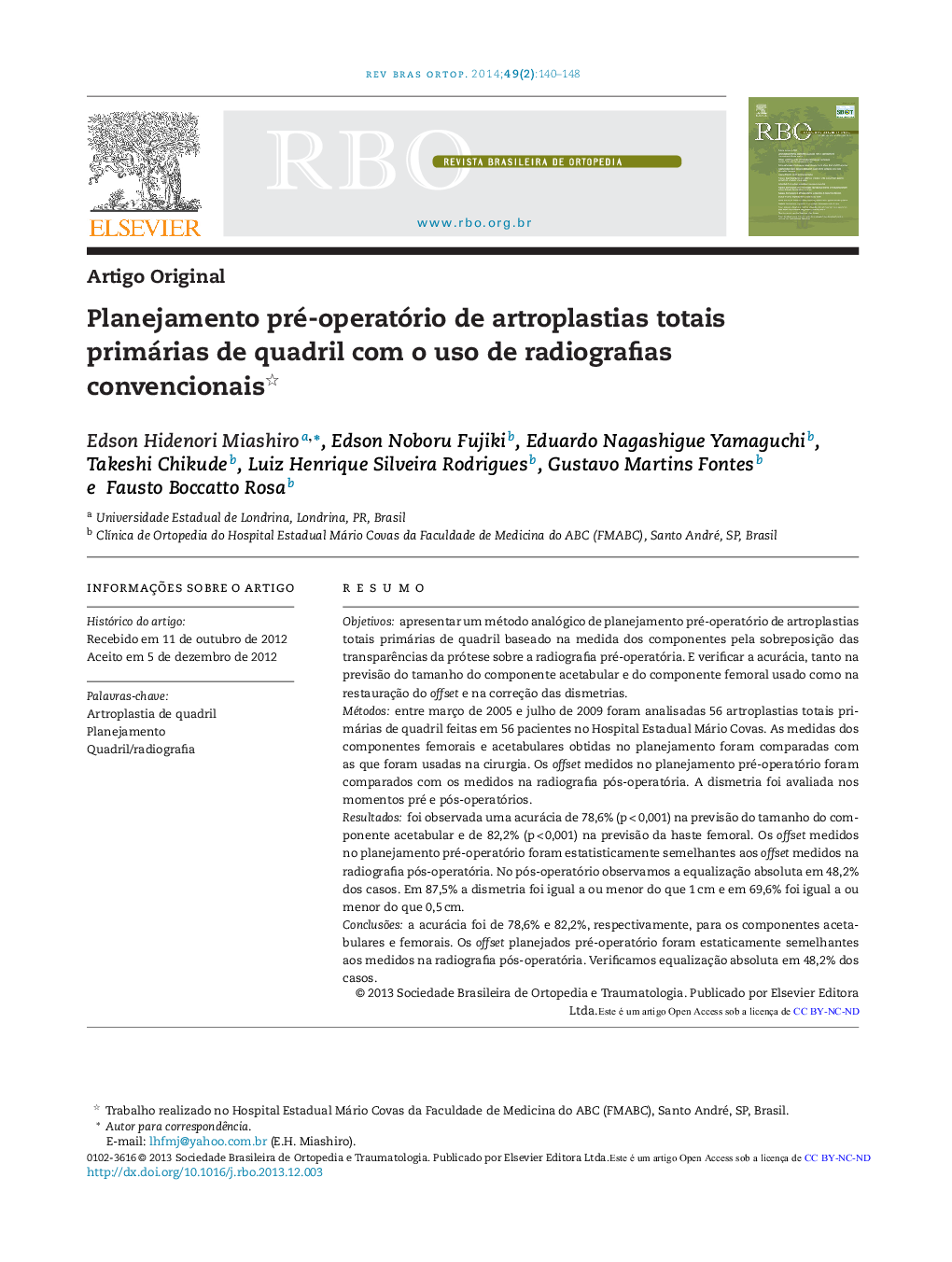| Article ID | Journal | Published Year | Pages | File Type |
|---|---|---|---|---|
| 2718108 | Revista Brasileira de Ortopedia | 2014 | 9 Pages |
ResumoObjetivosapresentar um método analógico de planejamento pré‐operatório de artroplastias totais primárias de quadril baseado na medida dos componentes pela sobreposição das transparências da prótese sobre a radiografia pré‐operatória. E verificar a acurácia, tanto na previsão do tamanho do componente acetabular e do componente femoral usado como na restauração do offset e na correção das dismetrias.Métodosentre março de 2005 e julho de 2009 foram analisadas 56 artroplastias totais primárias de quadril feitas em 56 pacientes no Hospital Estadual Mário Covas. As medidas dos componentes femorais e acetabulares obtidas no planejamento foram comparadas com as que foram usadas na cirurgia. Os offset medidos no planejamento pré‐operatório foram comparados com os medidos na radiografia pós‐operatória. A dismetria foi avaliada nos momentos pré e pós‐operatórios.Resultadosfoi observada uma acurácia de 78,6% (p < 0,001) na previsão do tamanho do componente acetabular e de 82,2% (p < 0,001) na previsão da haste femoral. Os offset medidos no planejamento pré‐operatório foram estatisticamente semelhantes aos offset medidos na radiografia pós‐operatória. No pós‐operatório observamos a equalização absoluta em 48,2% dos casos. Em 87,5% a dismetria foi igual a ou menor do que 1 cm e em 69,6% foi igual a ou menor do que 0,5 cm.Conclusõesa acurácia foi de 78,6% e 82,2%, respectivamente, para os componentes acetabulares e femorais. Os offset planejados pré‐operatório foram estaticamente semelhantes aos medidos na radiografia pós‐operatória. Verificamos equalização absoluta em 48,2% dos casos.
Objectivethe objective of this study was to present an analogue method for preoperative planning of primary total hip arthroplasty procedures based on measuring the components by overlaying the transparencies of the prosthesis on the preoperative radiographs and checking the accuracy, both for predicting the size of the acetabular and femoral components used and for restoring the offset and correcting the dysmetria.Methodsbetween March 2005 and July 2009, 56 primary total hip arthroplasty procedures performed on 56 patients at the Mario Covas State Hospital in Santo André were analyzed. The measurements on the femoral and acetabular components obtained through planning were compared with those that were used in the surgery. The offsets measured through the preoperative planning were compared with those measured on the postoperative radiographs. Dysmetria was evaluated before and after the operation.Resultsaccuracy of 78.6% (p < 0.001) in predicting the size of the acetabular component and 82.2% (p < 0.001) in predicting the femoral nail was observed. The offsets measured through preoperative planning were statistically similar to the offsets measured on the postoperative radiographs. After the operation, we observed absolute equalization in 48.2% of the cases. In 87.5%, the dysmetria was less than or equal to 1 cm and in 69.6%, it was less than or equal to 0.5 cm.Conclusionsthe accuracy was 78.6% and 82.2%, respectively, for the acetabular and femoral components. The offsets that were planned preoperatively were statistically similar to those measured on postoperative radiographs. We found absolute equalization in 48.2% of the cases.
